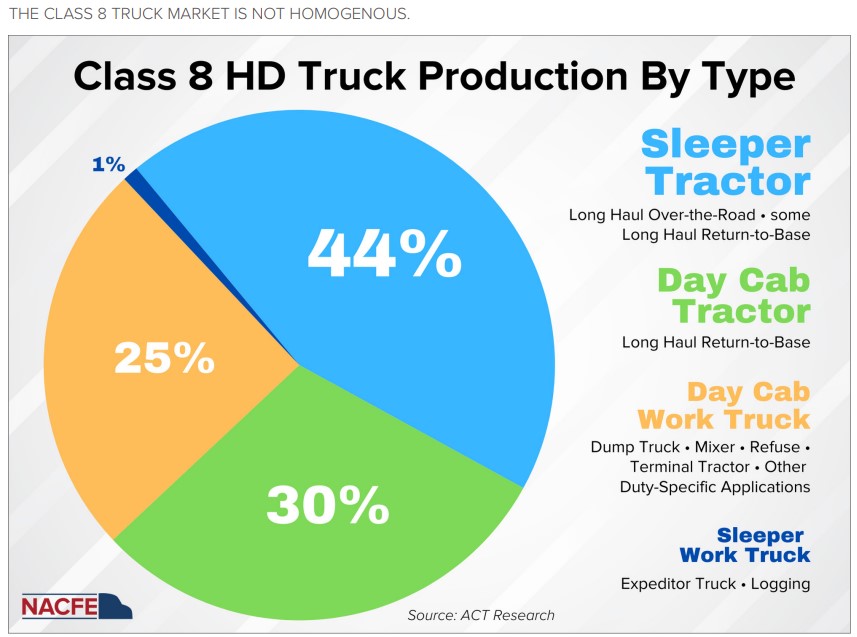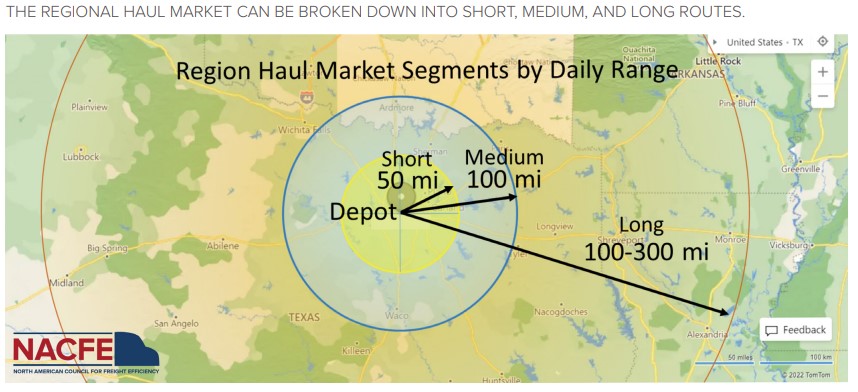The North American Council for Freight Efficiency (NACFE) believes that a new definition for longhaul trucking should include both long distance return-to-base operations as well as over-the-road ones.
NACFE cited the transformation to alternative fuels and the growth in regional for this change in a white paper, A Need to Redefine Class 8 Long-Haul Trucking. Understanding length of haul becomes critically important as the trucking industry moves through the “messy middle” with its myriad powertrain solutions.
The industry is changing to shorter length of hauls and more hub-and-spoke operations with a larger focus on day cab tractors and return-to-base operations, the document states.

It is not one homogenous market, rather it features a variety of truck sizes operating in a variety of duty cycles. The Class 8 truck market is not homogenous either as it includes both highway tractors and local trucks or work trucks.
Vocational trucks are made up of everything from construction dump trucks to concrete mixers, garbage trucks, terminal tractors and many more duty-specific applications. According to ACT Research those trucks typically make up 35% of heavy-duty truck production.
Standard language required
The rest of the market — 65% — is highway tractors. Those tractors can either be day cabs or sleepers. Day cabs are about 40% of tractor market production and sleepers are 60%.
It’s important for the trucking industry to use standard language and descriptions when discussing length of haul and NACFE has identified some definitions for length of haul.
Typically, short regional haul is less than 50 miles (80 km) out and back for a total of 100 miles (160 km). Medium regional haul is around 150 miles (241 km) out and back for a total of 300 miles (482 km) and long regional haul is 300 miles out and back for a total of 600 miles (965 km).

In some trucking operations the number of miles the truck drives in a single day are what defines the various lengths of haul.
In the final report for Run on Less Regional in 2019, NACFE offered a number of duty cycle categories for regional haul. There are even some return-to-base operations NACFE has described as long regional haul that are akin to over-the-road operations in that the total miles driven for a day is 500 to 600, a very long distance traveled within a single driver’s legal hours of service.
Growth in this sector also supports the truck driver’s desire to be home more often as the truck and driver return to base every day or every other day, according to NACFE.
Finally, there is the traditional segment, more commonly known as long haul, where instead of returning to base, the over-the-road driver spends their rest periods in the truck’s sleeper.
Battery efficiency and optimization
Currently if there are 200 gallons (757 litres) of fuel on a diesel-powered truck, and the truck averages 8 mpg (12 km per gallon), it can travel for about three days without needing to stop for fuel, according to NACFE.
Today’s battery electric powered trucks are capable of about 250 miles (402 km) on a single charge but can go much further when they can take advantage of opportunity charging. Also, longer ranges are probable with more efficient batteries and other systems being optimized moving forward.
This was demonstrated by the Tesla Semi deployed by PepsiCo in Run on Less – Electric Depot. The Tesla Semis saw ranges of 410 miles (660 km) on a single charge and one completed 1,076 miles (1713 km) in a 24-hour period.
Electric trucks
If battery electric trucks are going to have a place in over-the-road trucking, battery range needs to be improved and/or it needs to become faster and easier to recharge the truck’s batteries enroute, the document stated.
Both Run on Less – Electric and Run on Less – Electric Depot focused on trucks operating in shorter lengths of haul. Based on results and findings from those two events, and from developments in the trucking industry, NACFE believes that the short regional haul market can be served by battery electric vehicles and medium and longer hauls will become achievable as technology matures.
With Run on Less – Messy Middle, NACFE is expecting to capture real-world data on how vehicles with a variety of powertrains are performing in longhaul applications. The goal is to clear up some of the messiness surrounding powertrain options in long-haul trucking applications.
“Our industry is changing and that requires us to change as well, including the language we use to define things,” the document stated.
Regional haul utilizing day cab tractors is growing. This increase in return-to-base operations assists fleets in locating their truck fueling or charging for alternative fuels, while also supporting drivers’ desires to be home more often.